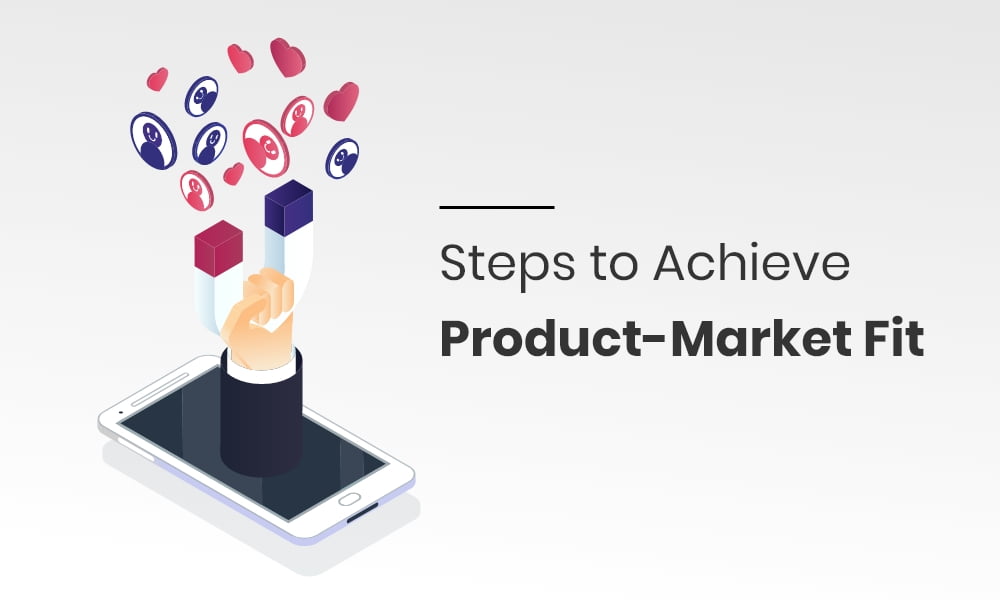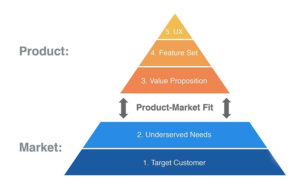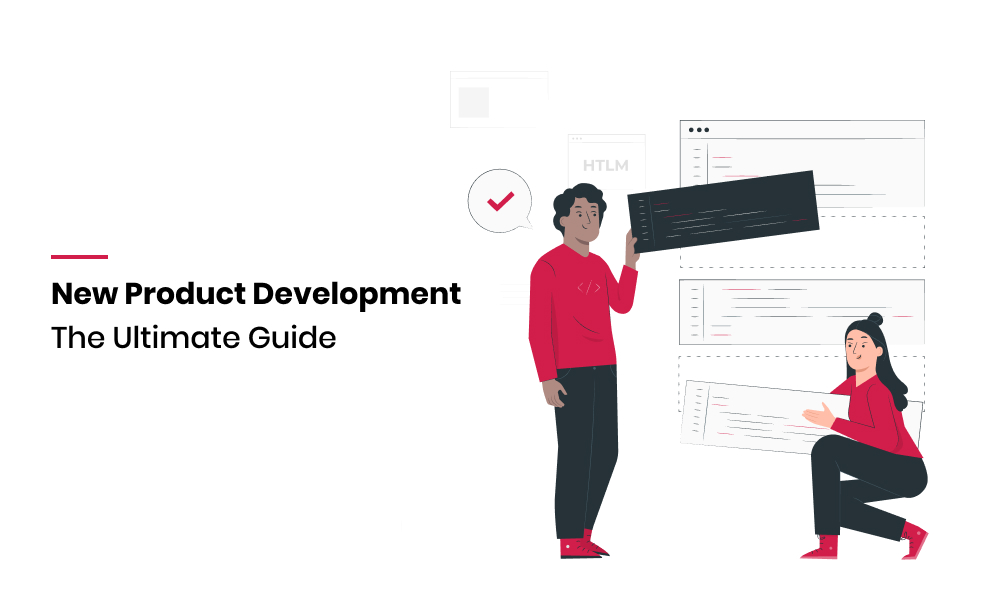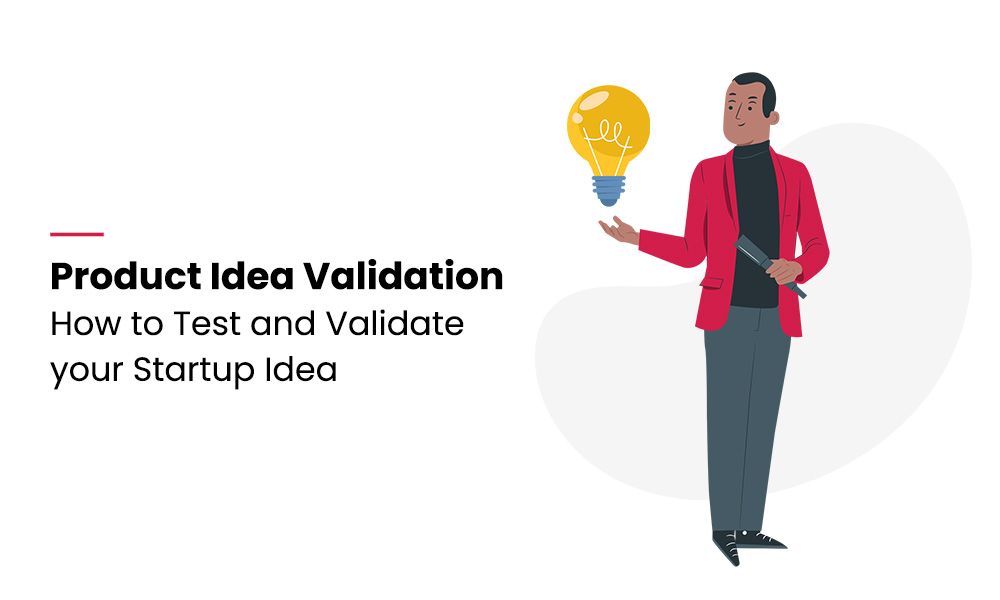Hi! My name is Shubham, and I have spent many years helping startup founders and entrepreneurs understand how to find product-market fit for their products.
So, you have a product that you believe will solve a problem that plagued the market for years. You’ve pulled dozens of all-nighters and brought your idea to life in the shape of a Minimum Viable Product.
Your product is ready, ripe for the taking. You’ve told friends, family and co-workers to check out your new baby. Everyone loves your product and gives you excellent feedback, but no one seems to use it. If this sounds like you, you’re at the right place.
As an entrepreneur, it is essential to know whether your target customers need your product or if they would eagerly pay for it. So, if your product is flying off the shelf and you are clamouring to meet this demand, you have attained a product-market fit.
What does product-market fit mean?
In 2007, Marc Andreessen—the co-founder of influential Silicon Valley venture capital firm Andreessen Horowitz wrote a blog post where he coined the term “product-market fit”. He described this as “being in a good market with a product that can satisfy that market.” Simply put, a product-market fit is a stage for a startup where they have successfully identified target customers and can serve them with the right product. When you attain this stage, you have found a product-market fit.
How to measure product-market fit?
Although there are no set rules or metrics that can help you find out when you’ve attained a product-market fit, you can tell when you’re going in the right direction, thanks to inputs from Andrew Chen—a venture capitalist. Andrew suggests using a mix of both qualitative and quantitative metrics to gauge success and to know how to find product-market fit. Here are some qualitative and quantitative metrics to help you get started.
Metrics for measuring product-market fit
Quantitative metrics
- NPS: NPS or Net Promoter Score measures the willingness of customers to recommend your startup’s product or service to others. NPS is used as an indication of your customers’ overall satisfaction with your product or service and is a good way to understand if customers love your product enough to recommend it or not.
- Churn rates: Customer Churn is the percentage of customers that cancel their subscriptions or stop using a product in a given time period. If the number of users moving on from your product is higher than the number of users coming in, you’ve got a problem on your hands.
- Growth rates: The growth rate is a factor measured in percentage that determines the acquisition of a customer base over a given time range. Your growth rate must always increase to indicate a product-market fit.
- Market share: The percentage of the market that your product commands are your market share.
Qualitative metrics
- Word of mouth
- Increased media outreach and coverage
What is a product-market fit pyramid?
Dan Olsen—the author of the book The Lean Product Playbook, created the product-market fit pyramid—an actionable model that uses five key components to define the product-market fit for your product.
This is a hierarchical model in which each pyramid layer relates to those above and below it. When you are building a successful product, you form a plausible hypothesis for each of these pyramid components. You then validate your key hypotheses against the Lean Product Process to improve your product-market fit.
What is the lean-product process?
Defined by Dan in The Lean Product Playbook, the lean product process guides you through each layer of the pyramid from the bottom to the very top. The process is iterative and easy to follow.
The six steps of the lean-product process will help you to find a product-market fit effectively. Here’s what you need to do:
-
Determine your target customer:
Before you start the lean product process, ensure that you perform market segmentation to understand your target customer clearly. Market segmentation involves dividing the market into segments that consist of potential customers who have similar needs and behaviours.
Your target customer will decide how well your product meets his or her needs. Define your target customer as well as possible so that everyone in your product development team knows who the product is for. You can do this well by creating user personas that describe your customer. You can start with a high-level hypothesis of the potential customer you have in mind and revise it as you tweak the features of your product while you iterate.
-
Identify underserved customer needs:
Once you’ve created a customer persona, you now define their underserved needs. Identify the needs that may have a good market opportunity. You can start by addressing these inadequately met needs, and create additional value for your customers.
-
Define your value proposition:
A value proposition is a plan that will drive product development to meet customer needs better than your product’s alternatives. In short, your value proposition is the essence of your product development strategy and will help you figure out features that will delight your customers and outperform the competition.
-
Specify your minimum viable product (MVP) prototype:
Your value proposition will also help you to specify and include this functionality in your MVP. This means that you will create a minimalistic product that your customers validate by accepting its viability. Hence, you build only what is needed to create adequate value for your target customers.
-
Creating your minimum viable product prototype:
Show your potential customers an early version of your product so you can use their feedback to iterate and improve the final product. You can use tools such as InVision to simulate user experience with interactivity. Tools like InVision will also help you obtain critical customer feedback.
-
Testing your minimum viable product with customers:
You can use a short survey or a screener to solicit feedback from your customers. A screener will ensure that your research participants have the target customer attributes. Here’s what you can do:
- Schedule one-on-one meetings with potential customers to test and then gather feedback.
- Ask questions during the test process to gather feedback, deep insights, and value.
- Avoid asking questions with a yes or no answer.
Once your tests are complete, interpret the feedback to identify similar patterns. This will help you to prioritize high-value customer concerns so that you can address them quickly. Once this process is complete, you can then refine the prototype to incorporate the required changes. Implementing this process at the outset will help product development teams use resources efficiently, and you can launch your product confidently—knowing that your customers will find your product valuable.
Remember, lean startups follow the build-measure-learn loop to create effective MVPs and implementing the lean product process will help you create a leaner, more customer-oriented MVP faster. If your startup is struggling with how to find a product-market fit, we can help. At Volumetree, we’ve built 100+ products across 17+ industries for startups and entrepreneurs.
We can help you find the right product-market fit, just like many of our clients, who have successfully transformed their MVPs into enterprise-grade products used by thousands of users every day.










This really answered my problem, thank you!
Excellent read, I just passed this onto a colleague who was doing some research on that. And he actually bought me lunch as I found it for him smile So let me rephrase that: Thanks for lunch! “Whenever you have an efficient government you have a dictatorship.” by Harry S Truman.
Hey there this is kind of of off topic but I was wondering if blogs use WYSIWYG editors or if you have to manually code with HTML. I’m starting a blog soon but have no coding know-how so I wanted to get guidance from someone with experience. Any help would be enormously appreciated!
naturally like your web-site however you have to test the spelling on several of your posts. Several of them are rife with spelling issues and I in finding it very troublesome to inform the reality on the other hand I’ll surely come back again.
Would you be excited about exchanging hyperlinks?
Pingback: naza24
Pingback: wholecelium reviews
Pingback: ชั้นวางสินค้าอุตสาหกรรม
Pingback: วิ่งแล้วคันยิบๆ
Pingback: โคเวย์
I like this post, enjoyed this one thanks for putting up. “No man is wise enough by himself.” by Titus Maccius Plautus.
Your style is so unique compared to many other people. Thank you for publishing when you have the opportunity,Guess I will just make this bookmarked.2
What Is Sugar Defender? Sugar Defender is a natural blood sugar support formula created by Tom Green. It is based on scientific breakthroughs and clinical studies.
Pingback: sidegra
Wonderful web site. Plenty of helpful info here. I¦m sending it to a few friends ans additionally sharing in delicious. And naturally, thanks on your effort!
Pingback: ร้านดอกไม้อารีย์
I believe this site has some real fantastic info for everyone. “To be able to be caught up into the world of thought — that is being educated.” by Edith Hamilton.
I appreciate, cause I found just what I was looking for. You’ve ended my 4 day long hunt! God Bless you man. Have a nice day. Bye
This is a very good tips especially to those new to blogosphere, brief and accurate information… Thanks for sharing this one. A must read article.
Very interesting topic, thankyou for putting up. “The height of cleverness is to be able to conceal it.” by Francois de La Rochefoucauld.
This actually answered my problem, thank you!
Hello! Quick question that’s completely off topic. Do you know how to make your site mobile friendly? My site looks weird when browsing from my iphone 4. I’m trying to find a template or plugin that might be able to resolve this problem. If you have any suggestions, please share. Appreciate it!
I found your weblog web site on google and verify just a few of your early posts. Proceed to keep up the excellent operate. I simply further up your RSS feed to my MSN News Reader. In search of forward to studying more from you in a while!…
Do you mind if I quote a few of your articles as long as I provide credit and sources back to your weblog? My website is in the very same area of interest as yours and my users would really benefit from some of the information you provide here. Please let me know if this ok with you. Regards!
There’s noticeably a bundle to learn about this. I assume you made certain good points in options also.
Hello. fantastic job. I did not imagine this. This is a great story. Thanks!
Lottery Defeater is an automated, plug-and-plug lottery-winning software.
You are my inspiration , I own few web logs and very sporadically run out from to brand.
I visited a lot of website but I think this one holds something special in it in it
Nice post. I was checking constantly this blog and I’m impressed! Extremely useful information specially the last part :) I care for such information a lot. I was seeking this certain info for a long time. Thank you and good luck.
Very nice info and right to the point. I don’t know if this is actually the best place to ask but do you folks have any ideea where to employ some professional writers? Thank you :)
Sweet website , super layout, rattling clean and utilise friendly.
Pingback: Phim tinh cam
Tonic Greens: An Overview. Introducing Tonic Greens, an innovative immune support supplement
Renew: An Overview. Renew is a dietary supplement formulated to aid in the weight loss process by enhancing the body’s regenerative functions
Renew: An Overview. Renew is a dietary supplement formulated to aid in the weight loss process by enhancing the body’s regenerative functions
so much excellent information on here, : D.
I precisely had to appreciate you once more. I am not sure the things that I would have tried in the absence of the entire opinions shared by you over that question. It absolutely was a very challenging problem in my view, however , finding out your well-written avenue you resolved that made me to leap over fulfillment. Now i am happier for your service and even believe you really know what a powerful job that you’re doing educating many people thru your blog post. Most likely you haven’t got to know all of us.
It?¦s really a cool and helpful piece of information. I?¦m glad that you just shared this helpful information with us. Please stay us informed like this. Thanks for sharing.
We stumbled over here from a different web address and thought I may as well check things out. I like what I see so i am just following you. Look forward to checking out your web page repeatedly.
We are a group of volunteers and starting a new scheme in our community. Your website provided us with valuable info to work on. You have done an impressive job and our whole community will be grateful to you.
Rattling instructive and excellent bodily structure of subject material, now that’s user friendly (:.
Some times its a pain in the ass to read what website owners wrote but this site is real user genial! .
Enjoyed reading through this, very good stuff, thankyou.
Thanks a lot for sharing this with all of us you really know what you are talking about! Bookmarked. Please also visit my website =). We could have a link exchange contract between us!
I am not rattling superb with English but I line up this really easygoing to understand.
hey there and thanks in your information – I’ve definitely picked up anything new from right here. I did then again expertise a few technical issues the usage of this web site, as I experienced to reload the web site many times previous to I may just get it to load correctly. I have been pondering in case your hosting is OK? Not that I am complaining, but sluggish loading cases times will often have an effect on your placement in google and could injury your high quality rating if ads and ***********|advertising|advertising|advertising and *********** with Adwords. Anyway I’m adding this RSS to my email and can look out for a lot more of your respective exciting content. Make sure you replace this once more soon..
Hey, you used to write great, but the last few posts have been kinda boring… I miss your super writings. Past several posts are just a little out of track! come on!
Your home is valueble for me. Thanks!…
I just couldn’t depart your web site before suggesting that I extremely enjoyed the standard info a person provide for your visitors? Is gonna be back often to check up on new posts
Some really nice and utilitarian info on this website, as well I believe the design and style has got fantastic features.
What is Renew? Renew is a dietary supplement designed to support blood flow while also aiming to boost testosterone levels andprovide an explosive energy drive
Thanks , I have just been searching for information about this topic for a long time and yours is the best I have came upon so far. But, what in regards to the conclusion? Are you certain about the source?
Very interesting topic, regards for posting.
Good website! I really love how it is easy on my eyes and the data are well written. I’m wondering how I might be notified whenever a new post has been made. I have subscribed to your feed which must do the trick! Have a nice day!
Somebody essentially assist to make significantly articles I might state. This is the very first time I frequented your website page and so far? I amazed with the research you made to create this particular put up incredible. Fantastic process!
Wow that was odd. I just wrote an incredibly long comment but after I clicked submit my comment didn’t show up. Grrrr… well I’m not writing all that over again. Regardless, just wanted to say fantastic blog!
Thanks for any other informative site. The place else may I am getting that type of info written in such a perfect way? I have a project that I’m simply now working on, and I have been on the look out for such info.
pin up az?rbaycan: pin up az?rbaycan – pin-up kazino
https://northern-doctors.org/# medicine in mexico pharmacies
reputable mexican pharmacies online: northern doctors pharmacy – mexican mail order pharmacies
mexico drug stores pharmacies: northern doctors pharmacy – mexican rx online
medication from mexico pharmacy [url=http://northern-doctors.org/#]mexican pharmacy online[/url] buying prescription drugs in mexico online
https://northern-doctors.org/# medicine in mexico pharmacies
buying from online mexican pharmacy: northern doctors – mexican border pharmacies shipping to usa
https://northern-doctors.org/# medication from mexico pharmacy
buying prescription drugs in mexico online: mexican pharmacy northern doctors – mexican border pharmacies shipping to usa
https://northern-doctors.org/# mexican border pharmacies shipping to usa
mexico pharmacies prescription drugs [url=http://northern-doctors.org/#]northern doctors pharmacy[/url] medicine in mexico pharmacies
buying from online mexican pharmacy: Mexico pharmacy that ship to usa – п»їbest mexican online pharmacies
https://northern-doctors.org/# pharmacies in mexico that ship to usa
buying prescription drugs in mexico: mexican pharmacy northern doctors – buying prescription drugs in mexico
https://northern-doctors.org/# pharmacies in mexico that ship to usa
mexican mail order pharmacies: mexican pharmacy online – reputable mexican pharmacies online
I found your blog web site on google and check a couple of of your early posts. Proceed to maintain up the excellent operate. I simply additional up your RSS feed to my MSN Information Reader. In search of ahead to reading extra from you in a while!…
mexican drugstore online: Mexico pharmacy that ship to usa – medicine in mexico pharmacies
reputable mexican pharmacies online [url=http://northern-doctors.org/#]northern doctors[/url] reputable mexican pharmacies online
https://northern-doctors.org/# mexico pharmacies prescription drugs
buying prescription drugs in mexico: mexican pharmacy – purple pharmacy mexico price list
Some genuinely nice and useful information on this website , also I think the pattern contains great features.
mexican online pharmacies prescription drugs: mexican northern doctors – mexico pharmacy
mexico drug stores pharmacies: mexican pharmacy – mexican pharmaceuticals online
mexico drug stores pharmacies: buying prescription drugs in mexico – mexican rx online
buying prescription drugs in mexico online [url=https://northern-doctors.org/#]mexican online pharmacies prescription drugs[/url] best online pharmacies in mexico
http://northern-doctors.org/# buying from online mexican pharmacy
mexican mail order pharmacies: northern doctors pharmacy – medication from mexico pharmacy
http://northern-doctors.org/# medication from mexico pharmacy
mexican rx online: northern doctors pharmacy – mexico pharmacy
buying from online mexican pharmacy [url=http://northern-doctors.org/#]mexican pharmacy northern doctors[/url] medicine in mexico pharmacies
https://northern-doctors.org/# buying prescription drugs in mexico online
buying from online mexican pharmacy: mexican pharmacy northern doctors – best online pharmacies in mexico
buying from online mexican pharmacy: mexican pharmacy northern doctors – buying prescription drugs in mexico online
https://northern-doctors.org/# mexican pharmacy
mexican drugstore online: mexican pharmacy northern doctors – medicine in mexico pharmacies
https://northern-doctors.org/# purple pharmacy mexico price list
mexican online pharmacies prescription drugs: northern doctors pharmacy – mexican pharmacy
mexican mail order pharmacies: mexican pharmacy – mexican mail order pharmacies
http://northern-doctors.org/# mexico pharmacy
mexican border pharmacies shipping to usa: mexican northern doctors – mexican mail order pharmacies
buying from online mexican pharmacy: mexican pharmaceuticals online – mexico pharmacy
https://northern-doctors.org/# п»їbest mexican online pharmacies
mexican mail order pharmacies: northern doctors – buying prescription drugs in mexico online
https://northern-doctors.org/# mexican drugstore online
buying prescription drugs in mexico online: northern doctors pharmacy – medication from mexico pharmacy
buying prescription drugs in mexico online: mexican pharmacy online – mexican mail order pharmacies
https://northern-doctors.org/# best online pharmacies in mexico
medication from mexico pharmacy: mexico drug stores pharmacies – mexico drug stores pharmacies
mexico drug stores pharmacies [url=https://northern-doctors.org/#]northern doctors[/url] mexican border pharmacies shipping to usa
medicine in mexico pharmacies: mexican pharmacy – reputable mexican pharmacies online
https://northern-doctors.org/# mexican border pharmacies shipping to usa
buying prescription drugs in mexico: northern doctors – reputable mexican pharmacies online
https://northern-doctors.org/# mexico pharmacies prescription drugs
reputable mexican pharmacies online: mexican northern doctors – mexican mail order pharmacies
mexican online pharmacies prescription drugs: mexican northern doctors – buying prescription drugs in mexico
https://northern-doctors.org/# buying prescription drugs in mexico online
buying prescription drugs in mexico: mexican pharmacy online – mexican online pharmacies prescription drugs
medicine in mexico pharmacies [url=http://northern-doctors.org/#]northern doctors pharmacy[/url] п»їbest mexican online pharmacies
https://northern-doctors.org/# pharmacies in mexico that ship to usa
mexican online pharmacies prescription drugs: northern doctors – mexico drug stores pharmacies
mexican pharmacy: mexican northern doctors – medication from mexico pharmacy
п»їbest mexican online pharmacies: mexican pharmacy – pharmacies in mexico that ship to usa
mexico pharmacies prescription drugs [url=https://cmqpharma.online/#]mexican pharmacy[/url] mexico drug stores pharmacies
https://cmqpharma.online/# mexico pharmacies prescription drugs
reputable mexican pharmacies online
mexican pharmaceuticals online [url=http://cmqpharma.com/#]mexico pharmacy[/url] mexican mail order pharmacies
mexican border pharmacies shipping to usa [url=https://cmqpharma.online/#]cmq pharma[/url] buying from online mexican pharmacy
mexican rx online [url=https://cmqpharma.online/#]mexican pharmacy online[/url] mexico pharmacy
mexican pharmaceuticals online
https://cmqpharma.online/# mexican online pharmacies prescription drugs
mexican rx online
purple pharmacy mexico price list [url=https://cmqpharma.online/#]mexican pharmacy[/url] п»їbest mexican online pharmacies
pharmacies in mexico that ship to usa [url=http://cmqpharma.com/#]mexican pharmacy[/url] mexican drugstore online
mexican mail order pharmacies [url=http://cmqpharma.com/#]mexican pharmacy[/url] buying from online mexican pharmacy
buying prescription drugs in mexico online [url=https://cmqpharma.com/#]cmq mexican pharmacy online[/url] medication from mexico pharmacy
reputable mexican pharmacies online [url=http://cmqpharma.com/#]mexican pharmacy[/url] purple pharmacy mexico price list
mexico pharmacies prescription drugs [url=http://cmqpharma.com/#]online mexican pharmacy[/url] mexican pharmaceuticals online
You have brought up a very excellent points, thanks for the post.
Awsome article and right to the point. I am not sure if this is actually the best place to ask but do you people have any thoughts
on where to hire some professional writers? Thanks in advance :
) Najlepsze escape roomy
You have mentioned very interesting points! ps decent internet site. “Where can I find a man governed by reason instead of habits and urges” by Kahlil Gibran.
Very interesting points you have remarked, thank you for
putting up..
buying prescription drugs in mexico online: cmq pharma – buying prescription drugs in mexico online
pharmacies in mexico that ship to usa
http://cmqpharma.com/# п»їbest mexican online pharmacies
buying from online mexican pharmacy
You should participate in a contest for among the finest blogs on the web. I will suggest this website!
mexican border pharmacies shipping to usa: cmq pharma – mexican drugstore online
mexican rx online
https://cmqpharma.com/# pharmacies in mexico that ship to usa
reputable mexican pharmacies online
What Is Java Burn? Java Burn is a natural health supplement that is formulated using clinically backed ingredients that promote healthy weight loss.
of course like your web-site however you have to take a look at the spelling on several of your posts. A number of them are rife with spelling issues and I find it very troublesome to inform the reality however I’ll surely come again again.
Your style is so unique compared to many other people. Thank you for publishing when you have the opportunity,Guess I will just make this bookmarked.2
Glad to be one of several visitors on this amazing web site : D.
you have a great blog here! would you like to make some invite posts on my blog?
buy prescription drugs from india: Online medicine order – top 10 pharmacies in india
mexican border pharmacies shipping to usa: mexican mail order pharmacies – mexican pharmacy
https://canadapharmast.online/# canadian valley pharmacy
reputable indian online pharmacy [url=https://indiapharmast.com/#]buy prescription drugs from india[/url] indian pharmacy
mexican border pharmacies shipping to usa: best online pharmacies in mexico – mexican mail order pharmacies
buy prescription drugs from india: india online pharmacy – indianpharmacy com
http://foruspharma.com/# п»їbest mexican online pharmacies
canadian pharmacy in canada [url=https://canadapharmast.com/#]canadianpharmacy com[/url] my canadian pharmacy reviews
mexican pharmacy: mexico drug stores pharmacies – buying prescription drugs in mexico online
purple pharmacy mexico price list: pharmacies in mexico that ship to usa – purple pharmacy mexico price list
legitimate canadian pharmacy: canadian drugs pharmacy – my canadian pharmacy review
http://canadapharmast.com/# best rated canadian pharmacy
buying prescription drugs in mexico [url=https://foruspharma.com/#]mexican mail order pharmacies[/url] mexico pharmacies prescription drugs
buy prescription drugs from india: indian pharmacy paypal – indian pharmacy
online pharmacy canada: canada drugs online reviews – my canadian pharmacy
best online pharmacies in mexico: mexican drugstore online – medication from mexico pharmacy
reputable canadian pharmacy: my canadian pharmacy rx – canadian family pharmacy
п»їbest mexican online pharmacies: mexican mail order pharmacies – medication from mexico pharmacy
http://clomiddelivery.pro/# can i purchase clomid without prescription
https://clomiddelivery.pro/# can you get clomid without prescription
order amoxicillin 500mg [url=http://amoxildelivery.pro/#]875 mg amoxicillin cost[/url] where to buy amoxicillin 500mg
http://clomiddelivery.pro/# cost cheap clomid now
Paxlovid buy online: paxlovid pill – buy paxlovid online
https://ciprodelivery.pro/# buy ciprofloxacin over the counter
doxycycline 200 [url=https://doxycyclinedelivery.pro/#]doxycycline 500mg tablets[/url] 631311 doxycycline
http://paxloviddelivery.pro/# paxlovid covid
http://ciprodelivery.pro/# cipro 500mg best prices
п»їpaxlovid [url=https://paxloviddelivery.pro/#]paxlovid india[/url] paxlovid covid
https://doxycyclinedelivery.pro/# doxycycline 20 mg coupon
where can i get cheap clomid for sale: can i buy cheap clomid – can i buy clomid prices
https://amoxildelivery.pro/# amoxicillin cost australia
http://clomiddelivery.pro/# buy generic clomid without rx
can you buy amoxicillin uk [url=http://amoxildelivery.pro/#]where can i buy amoxicillin over the counter[/url] how much is amoxicillin prescription
cipro for sale: ciprofloxacin over the counter – buy ciprofloxacin
https://ciprodelivery.pro/# buy generic ciprofloxacin
https://paxloviddelivery.pro/# Paxlovid buy online
cheap doxy [url=https://doxycyclinedelivery.pro/#]doxycycline capsules[/url] buy doxycycline 100mg uk
https://ciprodelivery.pro/# cipro for sale
http://ciprodelivery.pro/# ciprofloxacin generic
amoxicillin pharmacy price [url=https://amoxildelivery.pro/#]amoxicillin no prescipion[/url] amoxicillin online pharmacy
where can i buy cipro online: where can i buy cipro online – cipro pharmacy
http://clomiddelivery.pro/# how to get cheap clomid tablets
Regards for all your efforts that you have put in this. very interesting information.
https://amoxildelivery.pro/# buy amoxicillin 500mg online
paxlovid for sale [url=http://paxloviddelivery.pro/#]paxlovid buy[/url] paxlovid buy
https://paxloviddelivery.pro/# Paxlovid over the counter
Wow that was strange. I just wrote an extremely long comment but after I clicked submit my comment didn’t show up. Grrrr… well I’m not writing all that over again. Regardless, just wanted to say fantastic blog!
paxlovid pill: paxlovid covid – Paxlovid buy online
buy cipro without rx: cipro pharmacy – buy cipro without rx